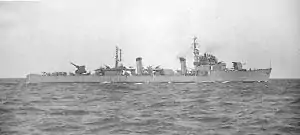Japanese destroyer Hagi (1944)
Hagi was one of 23 escort destroyers of the Tachibana sub-class of the Matsu class built for the Imperial Japanese Navy during the final stages of World War II. Completed in March 1945, the ship was slightly damaged in July by American aircraft. She was used to repatriate Japanese personnel after the war until 1947. Mid-year the destroyer was turned over to Great Britain and subsequently scrapped.
 Hagi, March 1945 | |
| History | |
|---|---|
| Name: | Hagi |
| Namesake: | Bush Clover |
| Ordered: | 1943 |
| Builder: | Yokosuka Naval Arsenal |
| Laid down: | 11 September 1944 |
| Launched: | 27 November 1944 |
| Completed: | 1 March 1945 |
| Stricken: | 5 October 1945 |
| Fate: | Turned over to the Royal Navy, 12 April 1947, and scrapped |
| General characteristics | |
| Class and type: | Tachibana sub-class of the Matsu-class escort destroyer |
| Displacement: | 1,309 t (1,288 long tons) (standard) |
| Length: | 100 m (328 ft 1 in) (o/a) |
| Beam: | 9.35 m (30 ft 8 in) |
| Draft: | 3.37 m (11 ft 1 in) |
| Installed power: |
|
| Propulsion: | 2 shafts, 2 × geared steam turbines |
| Speed: | 27.8 knots (51.5 km/h; 32.0 mph) |
| Range: | 4,680 nmi (8,670 km; 5,390 mi) at 16 knots (30 km/h; 18 mph) |
| Sensors and processing systems: | |
| Armament: |
|
Design and description
The Tachibana sub-class was a simplified version of the preceding Matsu class to make the Tachibanas even more suited for mass production. The ships measured 100 meters (328 ft 1 in) long overall, with a beam of 9.35 meters (30 ft 8 in) and a draft of 3.37 meters (11 ft 1 in).[1] They displaced 1,309 metric tons (1,288 long tons) at standard load and 1,554 metric tons (1,529 long tons) at deep load.[2] The ships had two Kampon geared steam turbines, each driving one propeller shaft, using steam provided by two Kampon water-tube boilers. The turbines were rated at a total of 19,000 shaft horsepower (14,000 kW) for a speed of 27.8 knots (51.5 km/h; 32.0 mph). The Tachibanas had a range of 4,680 nautical miles (8,670 km; 5,390 mi) at 16 knots (30 km/h; 18 mph).[3]
The main armament of the Tachibana sub-class consisted of three Type 89 127-millimeter (5 in) dual-purpose guns in one twin-gun mount aft and one single mount forward of the superstructure. The single mount was partially protected against spray by a gun shield. The accuracy of the Type 89 guns was severely reduced against aircraft because no high-angle gunnery director was fitted. They carried a total of 25 Type 96 25-millimeter (1 in) anti-aircraft guns in 4 triple and 13 single mounts. The Tachibanas were equipped with Type 13 early-warning and Type 22 surface-search radars.[4] The ships were also armed with a single rotating quadruple mount amidships for 610-millimeter (24 in) torpedoes. They could deliver their 60 depth charges via two stern rails and two throwers.[1][4]
Construction and service
Hagi (Bush Clover)[5] was ordered in Fiscal Year 1943 under the Modified 5th Naval Armaments Supplement Program as part of the Matsu class, but the design was simplified to facilitate production and the ship was one of those built to the modified design.[3] She was laid down on 11 September 1944 by Yokosuka Naval Arsenal, launched on 27 November and completed on 1 March 1945.[6] Hagi was assigned to Destroyer Squadron 11 of the Second Fleet on 1 April for working up and the squadron was reassigned to the Combined Fleet on 20 April. She became part of Destroyer Division 52 on 25 April together with Sugi, Kashi, Kaede, Nire and Nashi which was assigned to Escort Squadron 31 of the Combined Fleet.[5]
The ship was lightly damaged by American carrier aircraft during the airstrike on Kure on 24 July. The ship was turned over to Allied forces at Kure at the time of the surrender of Japan on 2 September and was stricken from the navy list on 5 October.[5] The destroyer was disarmed and used to repatriate Japanese personnel in 1945–1947. Hagi was turned over to Great Britain on 16 July of the latter year and subsequently broken up.[3]
Notes
- Chesneau, p. 196
- Whitley, p. 208
- Jentschura, Jung & Mickel, p. 153
- Stille, p. 41
- Nevitt
- Stille, p. 40
Bibliography
- Chesneau, Roger, ed. (1980). Conway's All the World's Fighting Ships 1922–1946. Greenwich, UK: Conway Maritime Press. ISBN 0-85177-146-7.
- Jentschura, Hansgeorg; Jung, Dieter & Mickel, Peter (1977). Warships of the Imperial Japanese Navy, 1869–1945. Annapolis, Maryland: United States Naval Institute. ISBN 0-87021-893-X.
- Nevitt, Allyn D. (1998). "IJN Hagi: Tabular Record of Movement". www.combinedfleet.com. Retrieved 22 June 2020.
- Stille, Mark (2013). Imperial Japanese Navy Destroyers 1919–45 (2): Asahio to Tachibana Classes. Botley, UK: Osprey Publishing. ISBN 978-1-84908-987-6.
- Whitley, M. J. (1988). Destroyers of World War Two: An International Encyclopedia. Annapolis, Maryland: Naval Institute Press. ISBN 0-87021-326-1.